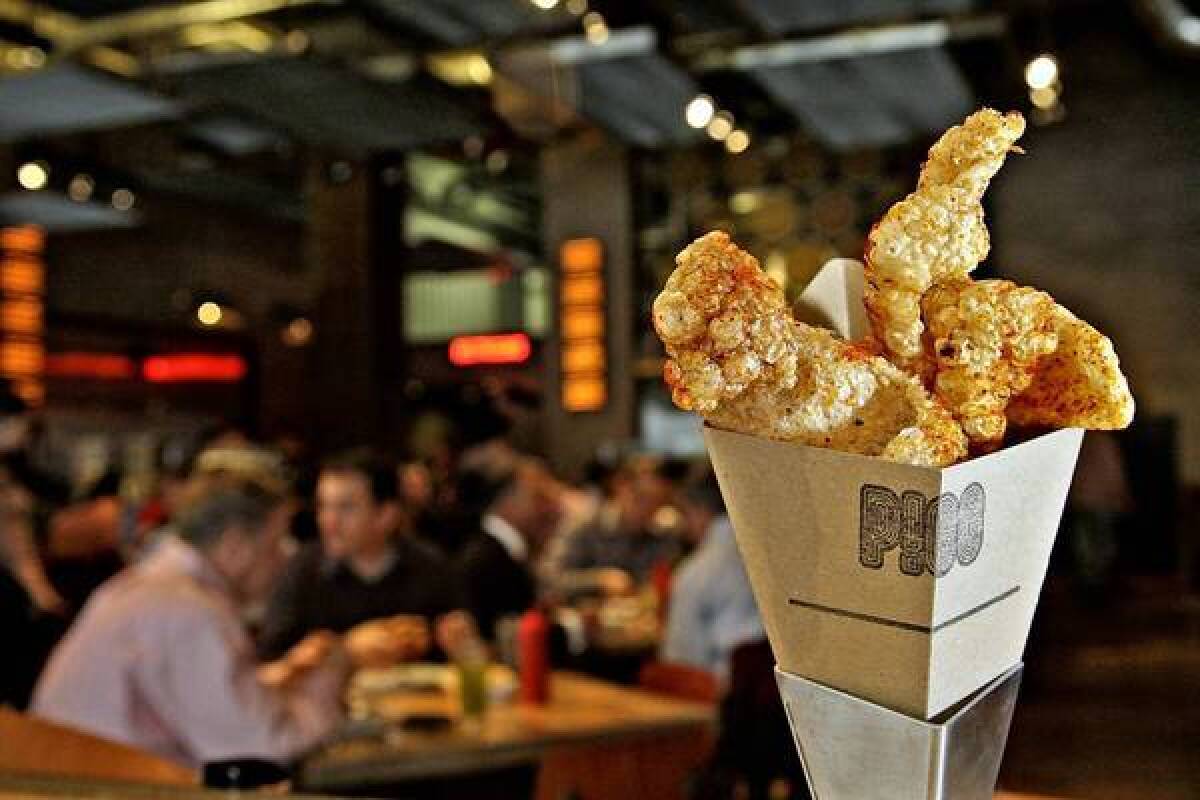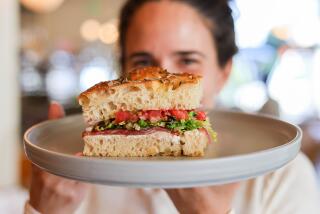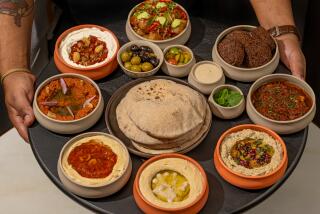Counter Intelligence: Umamicatessen in downtown L.A.

Everyone knows that Langer’s serves the best pastrami sandwich in town. Guidebooks say so. National magazines say so. The subway disgorges so many Langer’s-bound fressers that it has sometimes been called the Pastrami Express. Many of us think Langer’s serves the best pastrami sandwiches in the United States and consider any variance from its formula to be something close to heresy.
The idea of a pastrami sandwich at Umamicatessen, Adam Fleischman’s new deli on the edge of downtown’s Jewelry District, may border on the heretical even without the Langer’s comparisons. The deli, for one thing, which is identified on the menu as Cure, is only one of the stations in the restaurant, which is basically a branch of Fleischman’s popular Umami Burger that also incorporates kitchens specializing in doughnuts, coffee, booze and pork.
FOR THE RECORD:
Umamicatessen: A review of Umamicatessen restaurant in the May 12 Saturday section said that the restaurant’s pastrami sandwich was created by Micah Wexler. It was created by Adam Fleischman. —
The sandwich itself, designed by Micah Wexler of Mezze, the swank Middle Eastern restaurant on La Cienega’s Restaurant Row, is fairly spectacular, reimagined as a kind of steak sandwich. The meat is sliced at least a quarter-inch thick, laid out in orderly rows instead of being arranged into the customary wedge on the rye bread, and seasoned with seeded Dijon mustard instead of the customary splash of the brown stuff. I’m not saying it is the best pastrami sandwich in Los Angeles, but it is the first sandwich I have encountered in a lifetime of pastrami eating that might keep Norm Langer up at night.
Instead of an egg cream (there are no egg creams), you are invited to sip on bacon-infused bourbon garnished with fried slivers of pig’s ear. If you want fries with your sandwich, you can have them moistened with pickled Italian peppers, puréed ham, and an unlovely concoction of aioli and whipped pig’s brains the house has dubbed Brainaise.
Umamicatessen may not be the single least-kosher restaurant in town — that would be the swine-intensive bistro Animal, whose lease actually prevents it from competing with the observant Fairfax District establishments that surround it — but it is probably the least-kosher restaurant where it is possible to get a bowl of chicken soup, a corned beef sandwich and a knish. Fleischman joins the Gorbals’ Ilan Hall (Manischewitz-braised pork belly) and Lukshon’s Sang Yoon (Shanghai matzo ball soup), as well as Mezze’s Micah Wexler, who rocked a recent Cochon 555 event with pork-belly shawarma, pork-liver pastrami and pig’s blood cake with challah, in the cult of the Sacrilicious.
All the dishes at the restaurant are listed on a single, placemat-sized menu. From the dining room, which is ringed by the individual open kitchens — the Umami Burger preparations come from a separate kitchen in the back — you can order any of it: a blandly pleasant chicken salad with grapes from Cure, a turkey burger with green goddess dressing from Umami Burger or a glass of Bittberger pilsner from the bar.
In the first few weeks, a lot of the foodist attention was focused on Pigg, a restaurant-within-a-restaurant from Chris Cosentino, a chef notorious in San Francisco for his preparations of fish heads and turkey lungs at the restaurant Incanto and his cured meats at Boccalone in the Ferry Building Marketplace, where the most popular dishes include sno-cone cups filled with mortadella and lardo instead of sweetened ice. And some of the most obvious pleasures of Umamicatessen do come from Pigg: angular metal vases, like Art Deco artifacts, fitted with brown paper and filled with things like crunchy fried pig’s ears; rosemary-scented popcorn cooked in lard instead of oil; or fluffy, crunchy wisps of fried pigskin — cracklings — nearly as profound as the ones you may have enjoyed at Jazz Fest in New Orleans.
House-cured lardo (think meaty butter) and rillettes are served in tiny metal cans, opened with great ceremony at table. There is a sweetly funky country pork terrine; an elegant submarine sandwich with long-braised trotters and tongue made along the lines of a Vietnamese bánh mi — the Hoof and Mouth — and a surprisingly crowd-friendly take on the Sicilian sandwich vastedde, with sharp cheese, thinly sliced onions and a skinny slab of spleen.
There are 17 kinds of ham at Pigg, most of them displayed in a Ham Tower — bascially a kinetic sculpture crafted from glass, steel and pig — and for that alone we should be grateful to Cosentino. It is possible to find Parma prosciutto and San Daniele prosciutto all over Los Angeles, and jamón serrano from Spain isn’t rare, but it is hard to think of more than a couple of restaurants that feature even one country ham from America’s mid-South, much less half a dozen.
The opportunity to taste the smoked and unsmoked hams from the cult Tennessee smokehouse Benton’s or the Johnston County hams made from curly haired Mangalitsa hogs is pretty spectacular, if not precisely cheap. If you swing that way, you can even try paper-thin slices of raw pork from the famous Iberico de Bellota pigs from Spain, who fatten themselves with acorns in the forests in which they are allowed to roam. The meat is rich, dense and sharp, with a distinct aftertaste of chestnuts. Pigg is a charcuterie tour de force.
The doughnut concession, affiliated with the coffee mavens Spring for Coffee, bears the un-Googleable name “& a,”’ which probably sounded good after three or four Sazeracs. (For the record, Fleischman says the name is pronounced “And a Doughnut,” although the word “doughnut” is identified only with a pictogram, like that squiggly thing Prince used to identify himself for a few years.)
& a fries its doughnuts to order, which is unquestionably a good thing. You would really like the tres leches doughnut, soaked in its various dairy tinctures and served in a puddle of cajeta, Mexican caramel. The hot beignets, which come with a sort of pot de crème flavored with dark coffee and burnt citrus peel in the style of a New Orleans café brûlot, are pretty spectacular.
You should try the foie gras doughnut at least once: round, hot and crisp, dusted with ground peanuts. One end leaks jam — “forest berry”’ from the cult jelly man Robert Lambert in the Bay Area, which tastes like what the Wine Spectator means when they describe the jammy notes in a $150 Napa Cabernet Sauvignon — and the other a loose, mild foie gras mousse.
A cynical man might insist that the foie gras was put into the doughnut mostly to justify the cost of the jam: Nobody is going to pay $8 for a jelly doughnut, no matter how life-changing. But there is that sweet spot in the middle of the doughnut where foie meets jam, the peanut dust comes into play and you are essentially dealing with the most luxurious peanut butter and jelly sandwich in the world. It is an extraordinarily good bite. Then you’re left with the rest of what is merely an extremely good doughnut, but somehow that’s OK too.
LOCATION: 852 S. Broadway, Los Angeles, (213) 413-8626, umamicatessen.com.
PRICES: Ham plates, $10-$40; snacks and sides, $3-$10; sandwiches, $11-$14; burgers, $10-$15; salads and soups, $4-$10; doughnuts, $4-$8.
DETAILS: Open daily, 11 a.m. to midnight. Credit cards accepted. Full bar. jonathan.gold@latimes.com
More to Read
Eat your way across L.A.
Get our weekly Tasting Notes newsletter for reviews, news and more.
You may occasionally receive promotional content from the Los Angeles Times.







